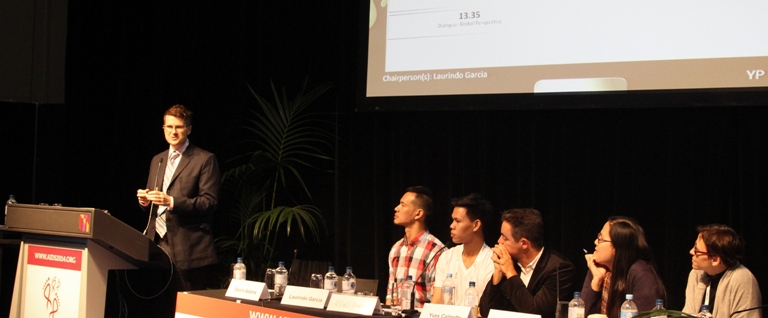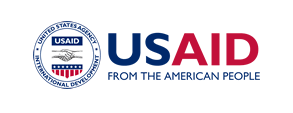The Health Policy Project ended in 2016. Work continued under Health Policy Plus (HP+) until 2022.
A (Cyber) Space for Community for HIV prevention

NEWS & VIEWS

Matthew Thomas, GRM International
By Cameron Hartofelis, Communications Specialist, Health Policy Project, Futures Group
MELBOURNE, Australia—Social media and Internet and communication technology (ICT) use for HIV prevention isn’t just for fun – it’s an innovative and important means of going further in coverage and scale for these programs.
This was the take-home message from “Like Me, Tweet Me, Post Me: Community Innovations Using Mobile and Online Technology by Gay Men, Men Who Have Sex with Men (MSM), and Transgender Persons (TG) for Youth HIV Programming.” The session was part of the AIDS 2014 Global Village, and provided a chance for community-based programs from Thailand, Philippines, Australia, and the United States to share their HIV programming for MSM and transgender communities using ICTs.
But why ICT for HIV, and why now?
With overall rates of HIV on the decline globally and rates among gay men and other men who have sex with men and transgender persons increasing, the panel provided a chance to reevaluate how to step up the pace and meet the needs of all who need care and support. Many lower and middle-income countries are skipping over desktop computing, diving straight into the mobile era for communication. ICTs, particularly mobile communication, provide new opportunities to more effectively reach and engage MSM and transgender populations with HIV testing and treatment.
In the July 21 session, FHI360’s Kim Green helped to contextualize the move towards utilizing ICT in HIV programming. She was managing a peer education network for HIV prevention program in Ghana, but it was only reaching a small subset of MSM in need of services in the area. Then a group of local MSM leaders suggested reaching out to potential clients via Facebook and Whatsapp. This change dramatically increased the reach of the program and rates of HIV testing, Green said.
Program coverage is important, but it’s not the only benefit of using ICT for HIV programming. Laurindo Garcia of the B-Change Foundation spoke to an important but less visible benefit of using ICT for health programming: empowerment. He called for broader MSM and trans engagement in developing ICT-based HIV interventions saying, “If we want to be serious about stepping up the pace we have to support capacity building for transgender individuals and MSM to take leadership of their advocacy.”
More work needs to be done to determine best practices for using communications and mobile technology for health interventions. UNAIDS’s Richard Burzynski, one of the co-presenters, summed up the challenges for those working to reach key populations with services well. “What do we have to do that’s different?” he asked. “The same old thing isn’t working.”
The panel also acknowledged the work of Carl Sandler, developer of the MISTER mobile application. Sandler works primarily in the private sector, and has been a vocal advocate for more public-private partnerships to fund and develop health campaigns and programming in order to reach those most in need with information and services.
Darrin Adams, senior HIV technical advisor with the Health Policy Project, told session participants that the HIV community needs to link the physical to the virtual and then back to the virtual with innovative systems for monitoring and evaluation.
Adams summed up the key points of the session as:
- MSM, gay men, trans, and LGBTI community-led ICT campaigns make a difference; not just as recipients of messages but dreamers of content and doers of implementation
- Private sector collaboration and partnership are crucial
- Data and evidence are still important; robust monitoring and evaluation systems are needed to demonstrate the importance and outcomes of ICT
- Social media and ICT are complementary to in-person methods and physical spaces
- Privacy, data security, and protection of offline and online identities must be top priorities
The panel was one prong of a strategy to increase the visibility of the grassroots innovations among MSM and trans people in the use of ICT. In September 2015, a special issue of the peer-review journal Digital Culture and Education will launch a collection of cases written by MSM and trans community leaders on how they integrated HIV programming with ICT. The co-editors represent USAID, amfAR (the Foundation for AIDS Research), and the USAID- and PEPFAR-funded Health Policy Project, and provided mentor and editorial support to contributors spanning Africa, Latin America, Europe, Southeast Asia, and the United States. A preview release of the special issue is available at http://www.digitalcultureandeducation.com/.
Miss the event but curious what was discussed? Check out the hashtag for the event, #MSMTransTech, to stay looped in to all the latest information at AIDS 2014 on the intersections of LGBT health and technology.
For more information on all of the Health Policy Project’s presence at the AIDS 2014 conference, check out our conference portal, here: http://www.healthpolicyproject.com/index.cfm?id=AIDS2014.
What's New
- Something to Build On: “Innovation Exchange” Celebrates the Health Policy Project’s Close and a New Beginning
- What Will it Take for Tanzania to Achieve ART Targets and Ensure Long-Term Sustainability of the HIV Response?
- Helping Kenya’s County Leaders Advocate for Increased Health Investments
- HPP Holds Working Meeting on Ensuring Responsible PEPFAR Transitions for Key Populations
- Health Policy Project Celebrates 2016 International Women's Day
- HPP Staff Participate in White House Conference on HIV Stigma Reduction

